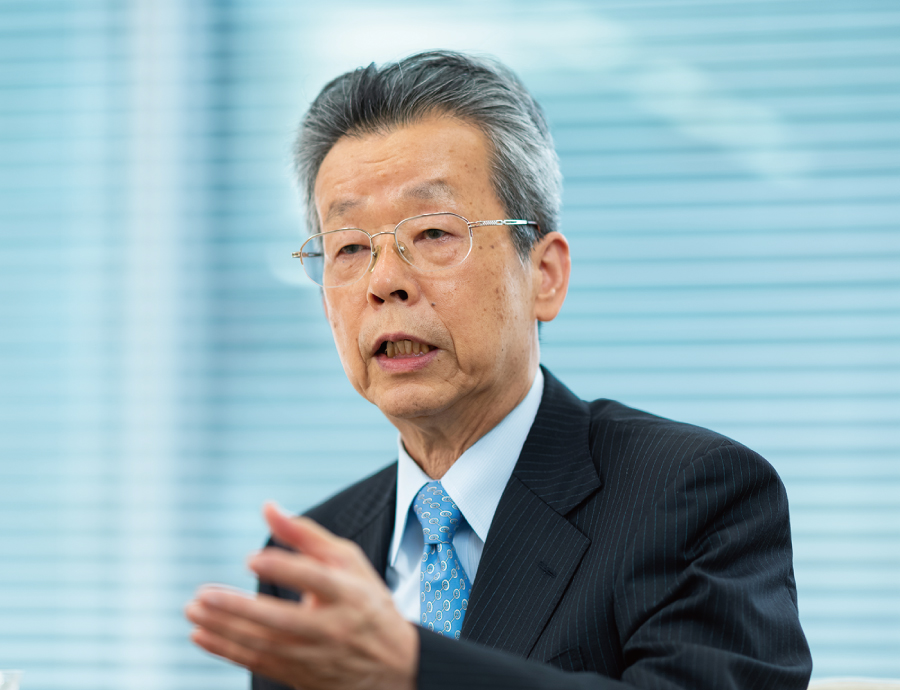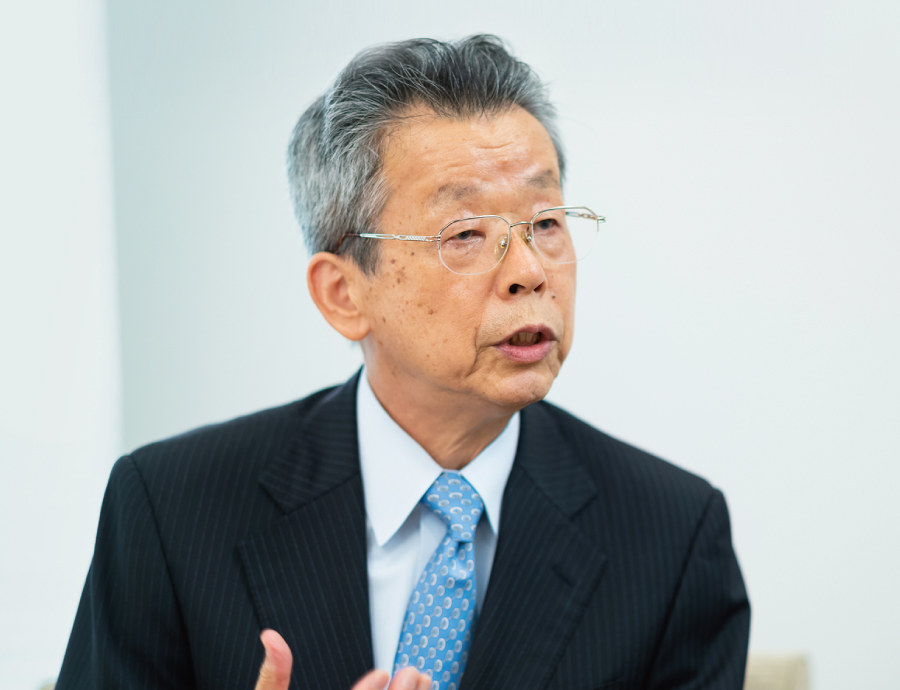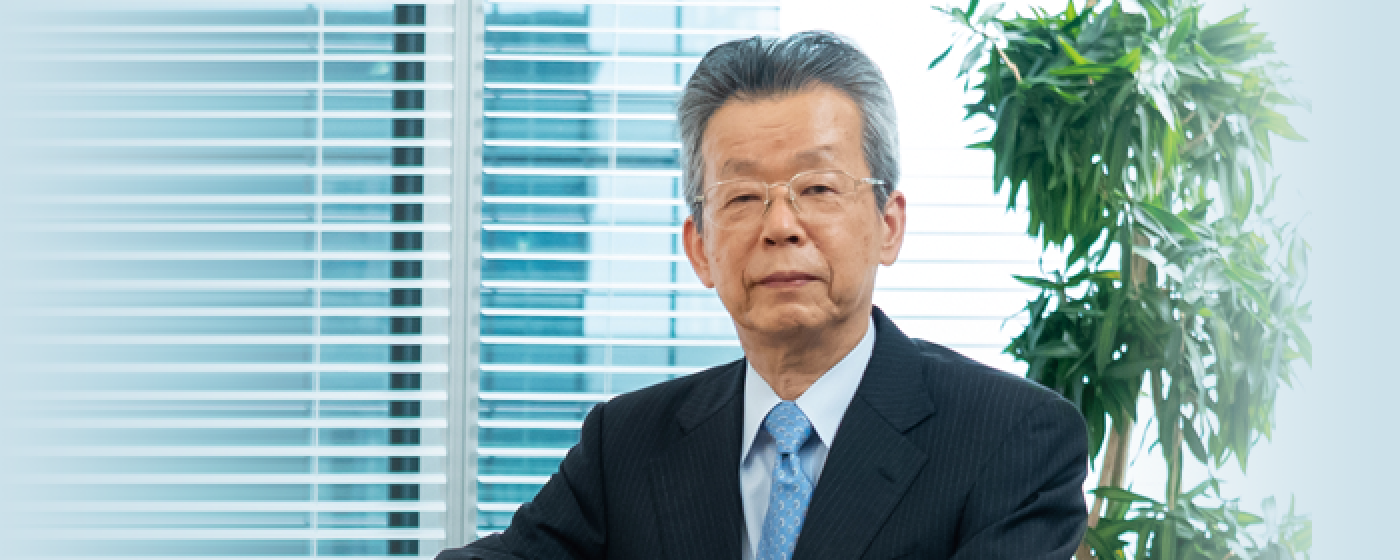- Akio Sakumiya
Independent outside director - Akio Sakumiya was formerly an executive vice president at Omron Corporation. At that company, he mainly supervised management as a non-executive director, serving as vice chairs of various committees in charge of human resources, remuneration, and nominating the president, while specializing in corporate governance and management of returns on invested capital.
UACJ’s corporate governance Steady progress in reforming management and the officer remuneration system
Two years have passed since I was appointed as an outside director at UACJ Corporation. I proposed corporate governance reforms after my appointment, but progress was not as quick as I expected. Later, however, reforms began to pick up pace, and now structural reforms are proceeding very quickly. Among the most important results of those reforms, the number of executive officers has been reduced and meetings of the Board of Directors have become more effective following improvements to the way the meetings are run.
Immediately after my appointment, I was surprised by the large number of executive officers, and concerned that the responsibilities of those officers and the Board of Directors had not been separated. For those reasons, I proposed improvements, and was rather stern when expressing my view that the Board had not served as a venue for serious deliberations in the past because of the failure to clearly separate those fundamental responsibilities. Specifically, executive officers are responsible for executing business while the Board of Directors is responsible for the supervision of that execution and management decision-making.
We made a huge step forward when this system was reorganized in April 2020. The number of representative directors was reduced from three to one, and the number of full-time directors serving concomitantly as executive officers was cut from eight to six. Moreover, the number of executive officers was significantly slimmed down from 27 to 14. Reducing the number of these officers has clarified their executive responsibilities and duties. Likewise, reducing the number of executive officers who also serve as directors while keeping the number of outside directors at four will lead to a clearer separation of the business execution and supervision functions.
How the Board of Director runs its meetings has also been improved. In the past, the Board was mainly a venue for reporting information and deciding on proposals. The Board received reports from each division with data explaining their performance, and made decisions regarding matters like investment plans. The outside directors asked various questions and offered their opinions regarding those decisions, but time was limited, so there was not much input from the full-time directors and executive officers. Consequently, deliberations were not thoroughgoing or dynamic.
In contrast, time for deliberations was added this fiscal year. In addition to the reports and resolutions, a fixed amount of time is scheduled specifically for deliberations, allowing the Board to have detailed discussions about the Company’s strategies, policies, and so on. As a result, the full-time directors have recently been participating more in discussions, and it seems like matters are being discussed in more depth.
This is not only the case with the Board; in divisional meetings, which are mainly led by executive officers, time has recently been designated for deliberations in addition to the routine activities of reporting and sharing information. In the past, members of the meetings just quietly listened to a series of reports lasting about five minutes each, but now they are actively engaged in discussions.
As another important reform, the officer remuneration system was recently revised. At UACJ, performance-linked compensation made up a very small percentage of total compensation, not only in comparison with companies overseas but even with guidelines set by the Japan Association of Corporate Directors. I argued that such a low percentage provided no incentives, and from that standpoint, a review of the system went ahead. Major revisions to the system were not made as the current mid-term management plan is still in effect, but the percentage of short-term performance-linked compensation was increased slightly, and total shareholder return was newly adopted as the indicator for performance-linked compensation over the medium and long terms in order to better align the interests of officers with shareholders.
In all of these ways, the Company’s corporate governance is steadily improving, and, in my view, is reaching the standards required by Japan’s Corporate Governance Code, although some issues remain. One of those issues is improving the Company’s succession planning. Future leaders need to be groomed by giving more opportunities to promising young and mid-career personnel at earlier stages of their careers, and expanding their capabilities through more challenging work assignments. I expect such initiatives to be included in discussions about strengthening corporate governance going forward.

Structural reforms and adoption of ROIC management Determined efforts to carry out comprehensive reforms
The UACJ Group began implementing structural reforms in October 2019 in an effort to quickly improve its performance and financial structure, which had weakened. In my opinion, that happened because the Company went ahead with large-scale investments to globalize its operations without sufficiently solidifying its revenue base by maximizing the effects of the merger following its establishment in 2013. In other words, the structural reforms are addressing issues that go back to the earliest time of the Company. The break-even point must by lowered by consolidating production plants in Japan, and rationalizing and raising the efficiency of their operations. The revenue base needs to be made more resilient to changes in the operating environment. These reforms are essential for UACJ’s continuity and growth in the future.
When the structural reforms were being drawn up, I made two strong requests. Firstly, I said the reform plan must be meticulously designed and comprehensive to make management feel confident that no lingering issues would remain after its completion. I also emphasized that unless the reforms were executed with strong determination, the Company might have to prepare for its dissolution. Thankfully, a comprehensive plan was put together under the direction of the president, and is being implemented across the entire UACJ Group. The plan was explained in a surprising level of detail when it was announced according to observers both inside and outside the Group. Investors appeared to recognize how seriously the Group is taking the reforms, so I expect they will be paying attention to the results.
After the reforms were launched, the Group’s operating environment became very difficult due to the impact of the trade war between the U.S. and China along with the worldwide spread of COVID-19. We cannot regard those factors as excuses, however, because unexpected changes can occur at any time. Even in such a tough operating environment, the Group must keep doing whatever is necessary to achieve its objectives and meet the expectations of its stakeholders. Toward those ends, I intend to offer as much support as I can as an outside director.
Among its management reforms, the Company adopted return on invested capital (ROIC) as a performance indicator a few years ago, but, regrettably, it has not achieved adequate results so far. I regard ROIC as a management tool for raising awareness of profitability in each division. The Company’s Finance and Accounting Division has been making preparations for the adoption of ROIC across the Company, such as providing a tool that shows data about expected levels of profit and invested capital by division. In the future, this management tool will be deployed in every division, and it will be essential for employees to use it regularly in order to understand things like how quickly collecting accounts receivable can improve ROIC.
Managing ROIC cannot work effectively, however, unless businesses are decentralized to a certain extent. Decentralization is beneficial if most of a company’s businesses operate well and only a few experience problems, but the opposite is true in the case of UACJ, so decentralizing its businesses will be difficult. For that reason, I believe the Group will need to quickly achieve its structural reforms in preparation for a full-fledged transition to ROIC management.

Towards future growth Pursuing innovations while ensuring strict financial discipline
In response to the COVID-19 pandemic, UACJ promptly set up an emergency response headquarters and acted very quickly. It put measures in place to cope with infected employees and prevent the spread of infections, drew up a business continuity plan based on the scenario of suspending operations at production plants, and allocated funds to prepare for an emergency situation.
During the time of the pandemic and after it is finally contained, the Group must complete its structural reforms as soon as possible and strive to expand its businesses in the coming years under its next mid-term management plan. The markets for aluminum can stock and auto parts will remain important, in my view, but the Company must stay on top of worldwide trends as a global player and refine its growth strategies to determine which businesses can expand and beat out the competition. In the next mid-term management plan, the Company should also integrate sustainability management practices into its business strategies to realize its purpose of contributing to the sustainability of society through its business activities.
In deliberations about the next mid-term management plan, I stressed the importance of two key points. The first is to ensure strict financial discipline. Pursuing growth is an important challenge, and I am very much in favor of it, but it should be pursued from a strong platform built on solid finances, earnings, and technology. Secondly, the Company needs to stand out more for its originality, which relates to technological capabilities. Aluminum’s environmental friendliness can be promoted by any manufacturer, so UACJ will have to offer such added value in its own unique way if it is to stay ahead of competitors.
Generally, people believe aluminum products are made using mature technologies, so they do not foresee any major innovations. In fact, most aluminum product manufacturers, UACJ included, allocate less than 1% of their net sales to research and development. This even raises the question of whether aluminum products should continue being made in developed countries when no technological innovations are expected.
UACJ’s management is well aware of this issue, and plans to have the Group compete by adding more value to products rather than just boosting sales volume. The challenge, however, is identifying the seeds and needs for differentiating and adding value to products, so they must be researched constantly and persistently. By studying industries in which new applications are emerging, such as electric vehicles and robotics, we may be able to identify needs for new materials. I hope the Company will take proactive steps towards systematically creating such innovations under its next mid-term management plan.


